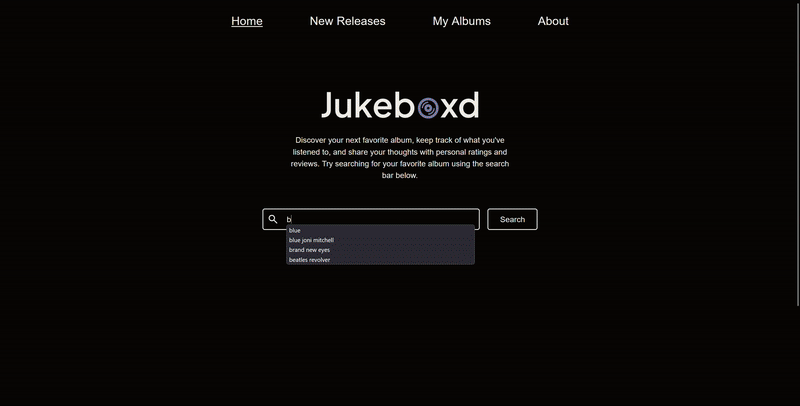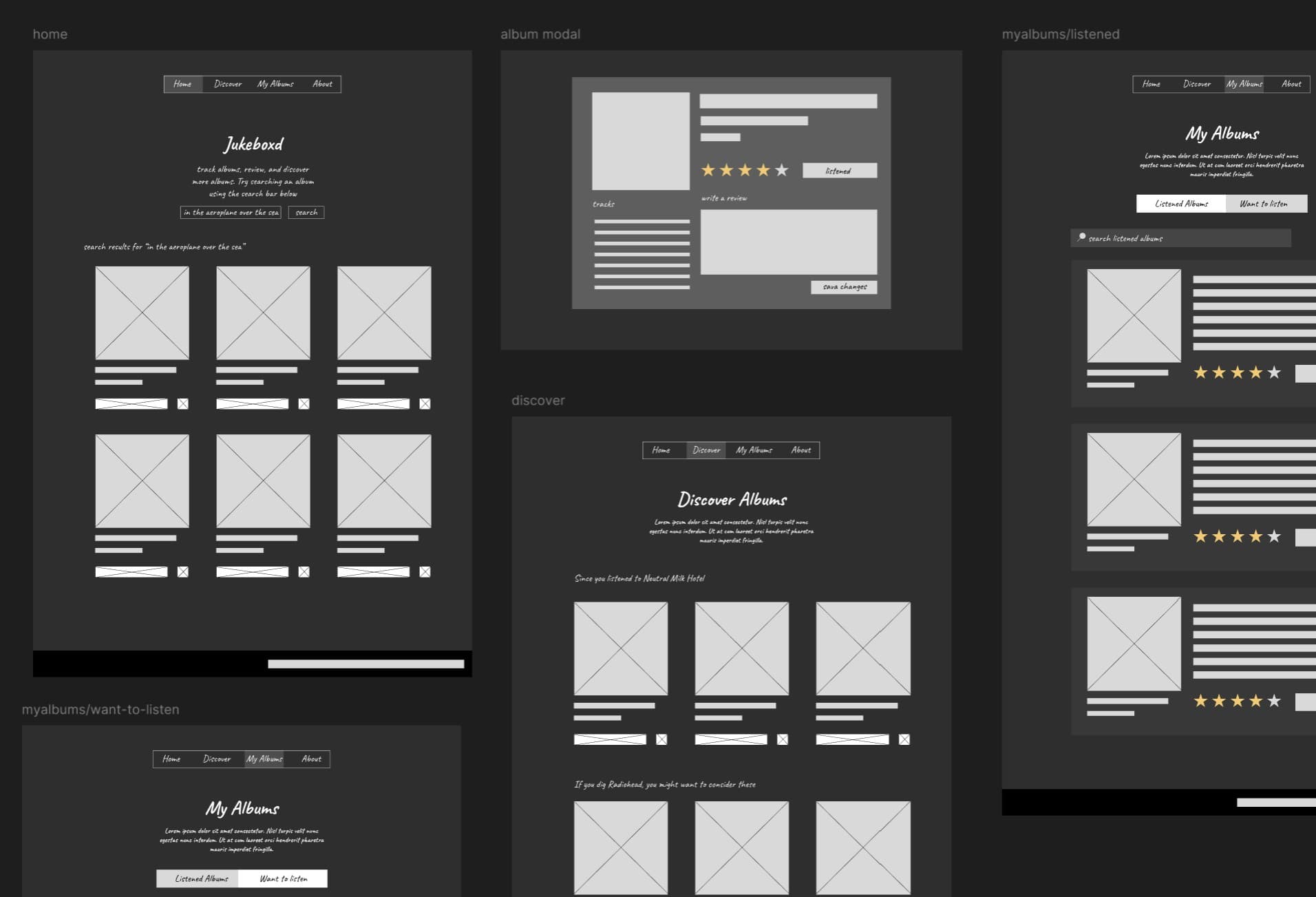Overview
Everyone loves music. I guess it's safe to say that the statement is no longer an opinion but more of a fact. In today's world, where streaming services are common, we have so many options that it can sometimes be difficult to have a focused music-listening experience.
Jukeboxd allows users to rate and review albums, add albums to their "Want to Listen" list, and keep up with new album releases. You can try the web app for yourself or visit the website's GitHub repository.

Users can rate and review albums using Jukeboxd
The idea for this project comes from my interest in music and my struggle to enjoy it in an increasingly distracting world. I'm also a regular Letterboxd user, which inspired the name Jukeboxd (not very creative, I know).
I am aware of existing music/album tracker websites like RateYourMusic and Discogs, but I wanted to create a similar app using the React Router Library and the Spotify Web API for this project.
Design Process
Before I started development, I wanted a clear design to follow. I aimed for a simple and intuitive interface and came up with the idea of placing a prominent search bar at the center of the homepage.
I also wanted to learn React Router, so I decided to create a navigation bar where users can navigate between four main pages: Home, New Releases, My Albums, and About.
Wireframes
Wireframing is very useful for generating ideas. Normally, I sketch wireframes by hand because it helps me quickly express random thoughts without distractions. However, for efficiency, I decided to create them directly in Figma. Wireframing allowed me to draft layouts quickly without worrying about discarding them if they didn't solve the problem.
During this process, I decided that album covers should be the focal point. I wanted them to be high in the visual hierarchy, making them large to mimic the feeling of browsing for albums in a record store.

Initial wireframes of Jukeboxd
Mock
After finalizing the wireframes, I applied colors and typography to the design. I kept things simple and clean by using a sans-serif font and generated a color palette using Realtime Colors. I've used this tool so much that I feel like I'm over-relying on it—but if you struggle with color theory like I do, I highly recommend checking it out!
At this stage, I also realized the importance of designing empty states—for example, when a user hasn't added anything to their list or when the Spotify API fails to return search results.

The final design mock
Developing The App
Now comes the fun part—bringing the website to life. Below, I'll break down the technologies I used and explain them in a simple way.
React Router 7
React Router is a popular library for managing navigation in React applications. It allows me to create routes using the built-in <Route> and <Routes> components. Here's a code snippet showing how I used React Router in my website:
const router = createBrowserRouter(
createRoutesFromElements(
<Route path="/" element={<RootLayout />}>
<Route index element={<Home />} />
<Route path="new-releases" element={<NewReleases />} />
<Route path="my-albums" element={<MyAlbumsLayout />}>
<Route index element={<ReviewedAlbums />} />
<Route path="want-to-listen" element={<WantToListenAlbums />} />
</Route>
<Route path="about" element={<About />} />
<Route path="*" element={<NotFound />} />
</Route>
)
);
Tailwind CSS v4.0
Tailwind CSS is a utility-first CSS framework that lets me style Jukeboxd using pre-built classes instead of writing custom CSS. Here's a comparison of traditional CSS and Tailwind:
Traditional CSS
.edit-button {
margin-left: auto;
margin-top: auto;
padding: 2px 6px;
background-color: var(--primary);
font-weight: bold;
color: var(--background);
border-radius: 2px;
}
Tailwind CSS
<button className="ml-auto mt-auto px-1.5 py-0.5 bg-primary font-bold text-background rounded-sm">
Edit Review
</button>
At first, I thought Tailwind CSS went against the DRY (Don't Repeat Yourself) principle since you have to write styles for every component. But after using it, I found it surprisingly convenient. Instead of managing long CSS files, I could build components quickly without worrying about unused styles cluttering my codebase. With Tailwind, every interface component is easily disposable, making development more efficient and flexible.
Vite
Vite is a modern tool for building web apps, especially since I use React as my main library. It's faster than traditional bundlers like Webpack because Vite only refreshes the parts of the app that change. I also chose it because the setup is very simple for someone who's not particularly hacky.
Room for Improvements
Since this project originally served as an opportunity for me to learn React Router and Tailwind CSS, there are a few things I'd like to improve in the future when I have the time. Here are some areas that could use enhancement:
- Currently the app uses localStorage to store reviewed albums. I'd like to implement Firestore authentication and integrate Firestore database functionality into the app.
- I'd like to replace the "New Releases" page with one that shows personalized recommendations based on users' reviewed albums.
- Since App Router was introduced in Next.js 13, I think it would be easier to migrate this project into a Next.js framework. (I'm a big fan of App Router)